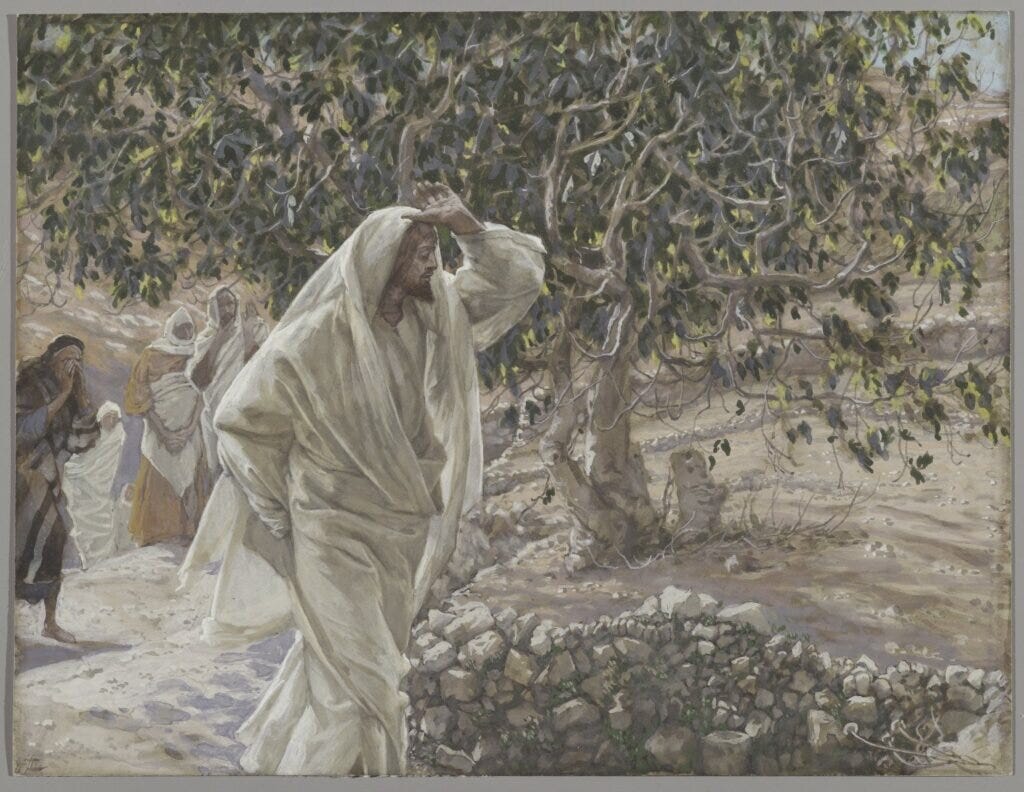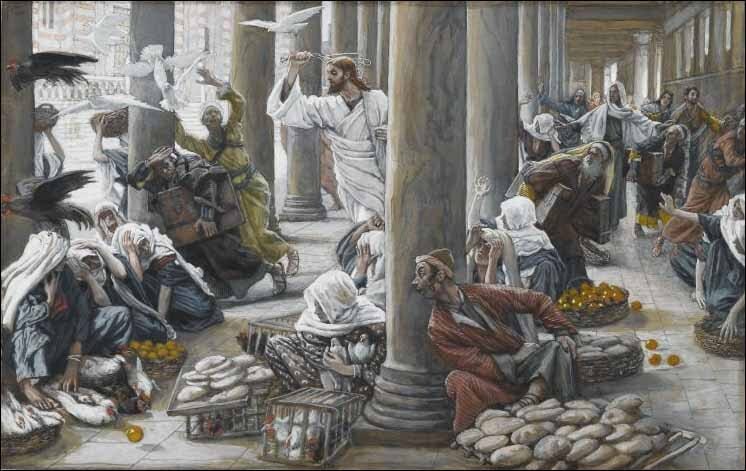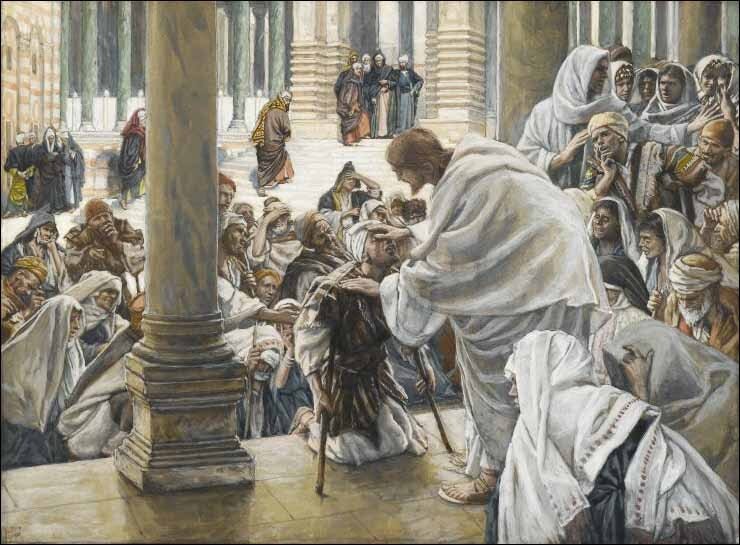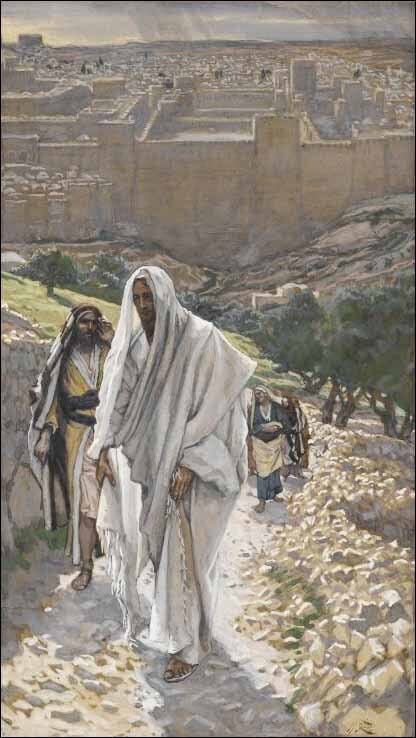Great and Holy Monday
Monday of Holy Week Illustrated By James Tissot, with Commentary by Dom Guéranger and Tissot
The Accursed Fig-tree
Saint Matthew 21:18-22
Now in the morning as he returned into the city, he hungered.
And when he saw a fig- tree in the way, he came to it, and found nothing thereon, but leaves only, and said unto it, Let no fruit grow on thee henceforward for ever. And presently the fig-tree withered away.
And when the disciples saw it, they marvelled, saying, How soon is the fig-tree withered away!
Jesus answered and said unto them. Verily I say unto you. If ye have faith, and doubt not, ye shall not only do this which is done to the fig-tree, but also if ye shall say unto this mountain. Be thou removed, and be thou cast into the sea ; it shall be done.
And all things, whatsoever ye shall ask in prayer, believing, ye shall receive.
From Dom Guéranger's The Liturgical Year
This morning, also, Jesus goes with His disciples to Jerusalem. He is fasting, for the Gospel tells us that He was hungry. He approaches a fig-tree, which is by the way-side; but finds nothing on it, save leaves only. Jesus, wishing to give us an instruction, curses the fig-tree, which immediately withers away. He would hereby teach us what they are to expect, who have nothing but good desires, and never produce in themselves the fruit of a real conversion. Nor is the allusion to Jerusalem less evident. This city is zealous for the exterior of divine worship; but her heart is hard and obstinate, and she is plotting, at this very hour, the death of the Son of God.
Tissot Commentary
Judea is the land of the fig-tree, and throughout the whole year its foliage beautifies the lower districts of the valleys near the springs and watercourses. On the slopes of the mountains, too, the fig-trees make patches of shade in the fields of wheat and barley, and even on the mountain tops they occur amongst the olives, to bear witness to the ownership of man and to the wealth of cultivation throughout the entire country. Travellers recognize three varieties of the fig-tree in Judea, and these three are also referred to in the Talmud. First, there are the black or white figs, which are ripe in the month of June; then, the summer figs, which ripen in August, and it was doubtless beneath a tree of this second kind, during the time of vintage, that Jesus first saw Nathanael, when one look from Him changed his very soul. Lastly, there are the long-shaped violet figs which remain on the trees all the 'winter and are not gathered till the spring. Most of these trees, if they are sheltered from the wind, retain their foliage throughout the bad season unless the winter should be unusually severe, and the fig-tree of Egypt. thanks to the exceptional climate of the Delta, and the constant humidity of the soil, sometimes yields seven crops in one year.
Christ Driving Out Them that Sold in the Temple
From Dom Guéranger's The Liturgical Year
The greater portion of the day is spent in the temple, where Jesus holds long conversations with the chief priests and ancients of the people. His language to them is stronger than ever, and triumphs over all their captious questions. It is principally in the Gospel of St. Matthew that we shall find these answers of our Redeemer, which so energetically accuse the Jews of their sin of rejecting the Messias, and so plainly foretell the punishment their sin is to bring after it.
St. Matthew 21:12-13
AND Jesus went into the temple of God, and cast out all them that sold and bought in the temple, and overthrew the tables of the moneychangers, and the seats of them that sold doves,
And said unto them. It is written, My house shall be called the house of prayer; but ye have made it a den of thieves.
Tissot Commentary
…[A] few words on the circumstances which led to this action of Jesus, an action apparently violent, but in reality quite natural. Between Solomon’s Porch and the outer wall of the Temple on the eastern side, there was a certain space set apart for the animals to be offered up in sacrifice. It was from this space, after a first selection had been made, that they were taken to the Priests whose duty it was to examine them carefully according to rigidly prescribed rules, when they were led to the sheep-pool to be purified. In the space above referred to, which was a kind of long narrow passage, there were beneath the portico a number of little vaulted rooms resembling the shops in a bazaar, where congregated the buyers, money-changers and merchants. The premises, however, soon became too small, and the traders in animals gradually encroached on the other portions of the Temple. To begin with, the money-changers, going up a few steps, took their stand on the right and left of Solomon's Porch, others imitated their example, and soon the entire colonnade was invaded, especially at the time of the great festivals. Nor did the abuse end there: even the Court of the Gentiles was in its turn invaded and defiled by the animals bought and sold in it. Nozv, this court was paved with large polished stones witli a slope managed, as already explained, so as to receive rain water and conduct it to the cisterns. The water in the cisterns of the Temple must, therefore, have been contaminated by impurities, whilst the silence of the sacred precincts was broken by all the confused noises of the market. Preaching, prayer and quiet meditation were all alike impossible; the state of things was scandalous; no one could now retire to the cool shade of the Temple in the morning, for it was then that the traffic was at its height. Everyone reali:(ed the abuses resulting from the deplorable invasion; but no one had the courage to take the initiative in trying to put a stop to it. Jesus alone, with the authority which radiated forth from His personality, could have hoped to bring such an attempt to a successful issue. He took off a kind of girdle, made of rope, which He wore round His robes, twisted it into a sort of scourge and used if as a whip to drive out them that sold. Behind Him in procession followed His disciples who, amidst great confusion, gradually cleared out the purchasers, till the portico was restored to its original tranquillity .
There can be no doubt that everybody except the merchants themselves, who were thus unceremoniously hustled out with their goods and chattels, was very glad of this successful measure of repression; the people could not fail to appreciate the fact that the healthiness of the Temple had gained greatly in every way; whilst the cleansing of the porticoes and their restoration to tranquillity were of paramount importance to them as the spots sacred to religious worship. Moreover, the purification of the waters of the cisterns; the restoration of the place set apart for the teaching of the prophets: the return of sanctity to the holy spot; in a word, everything combined to make the intervention of Jesus peculiarly opportune. The High Priests alone, the exalted officials of the Jewish nation, on whom had devolved the right of organising the police of the Temple, were hurt at the initiative being thus taken out of their hands, feeling that it was of the nature of a reproach to them. This view will come out clearly presently when they will go in a body to seek Jesus and demand of Him « by what authority doest Thou these things and who gave Thee this authority? » Furious as they already were at the ever-growing influence of Jesus, they would not pardon Him for an act of authority of such signal impressiveness and in such direct opposition to what they looked upon as their own rights.
Jesus Forbids the Carrying of Vessels Through the Temple
St. Mark 11:16
AND would not suffer that any man should carry any vessel through the temple.
Tissot Commentary
Jesus, having under taken to restore order in the House of His Father, did not content Himself with the first sweeping reform just described . Yet another abuse had crept in: namely, the crossing of the Temple with various vessels in which to fetch water more conveniently than by going round. To understand more clearly how this custom came to be introduced, what has already been said about the system of the water supply of Jerusalem must be borne in mind. We know, indeed we have Just repeated, that all those portions of the Temple open to the sky were paved with polished stones and, in some parts, with many coloured marbles intended to receive rain water and take it to the cisterns or reservoirs. These reservoirs were numerous, and were much frequented by the women of the town , who flocked to them to draw water for their domestic needs. Besides rain water these reservoirs received the water from the sealed fountain on the further side of Bethlehem and Etam, beyond the Wadi Urtas. The water from Solomon's Pools was also diverted to them by means of the aqueducts already referred to. The reservoirs thus fed were celebrated, and their water was much sought after on account of its freshness and purity; the people, however, preferred to draw it from the cisterns adjoining the Temple to going to fetch it from outside the town at Amygdalum or in the reservoirs of the Valley of Gihon. This was the cause of the perpetual going and coming zuhich destroyed the retirement of the Temple. It was not, however, the only one, for all those who wished to go to any place beyond the Temple preferred taking a short cut through it to going round the whole of the vast enceinte, which would have involved a very wide détour.
The same kind of thing may often be seen in Italy, in the Duomo of Florence, for instance, where bakers, porters and workmen pursuing their various avocations cross the sacred building to avoid going round by the road and to enjoy being in the shade for a moment or two. But Jesus could not bear to look on at such an abuse; He therefore forbade everyone to cross the Temple carrying loads, so as to restore to the consecrated spot the quiet and seclusion which rightly belonged to it.
At the present day it is still forbidden to cross the Haram, as the site of the Temple is now called, but the Pasha of Jerusalem has made an exception in favour of the sisters of Saint Vincent de Paul, for he is full of admiration for the charitable zeal which leads them to go from hospital to hospital throughout the town , ministering without distinction to all sufferers whether Christian or Mahommedan.
The Healing of the Lame in the Temple
Matthew 21:14
AND the blind and the lame came to him in the temple; and he healed them.
Tissot Commentary
The scene referred to in the Gospel must have taken place in the Court of the Women about seven o'clock in the morning, beyond the shade where the crowd is massed in my picture. There could have been none but Jews present, for to reach this court it was necessary to pass through the Chel or terrace surrounding the actual buildings of the Temple to which, as is well known, Gentiles were not admitted. The Temple at this early hour is full of the poor; the rich with their wide phylacteries and their gorgeous fringes will arrive later. In the distance can be seen the semi-circular steps of the Degrees, or Psalms, at the base of which devotees danced with torches in their hands at the ceremony of water-pouring at the Feast of Tabernacles. Originally this Festival was celebrated by a mere procession; but later, with a view to making it more impressive, specially decorated torches were introduced, and, as with all such customs, abuses gradually crept in. The Talmud refers to certain eccentricities of behaviour which drew considerable attention on those who practised them. Ben Jocades, for instance, boasted of the extraordinary leaps he took at the celebrations of festivals. We are also told that 'Ben Simon ben Lakist danced whilst juggling eight golden torches at once without letting them touch each other or dropping a single one. He bent his knees, linked his thumbs together, turned a somersault, and with a rebound stood once more upright, which reads, as will strike everyone, like a description of some modern acrobat's dangerous feats. In these festivals, moreover, if we are to believe the Talmudic accounts, there ivere singers zcho did wonderful things with their voices : a certain Higros, we are told, had an immense variety of melodies in his repertory, and, by putting his thumb in his mouth as he sung, he produced such extraordinary modulations of sound, that his brother Priests held their heads in both hands in their astonishment. This may bw quoted as an example of the silly, futile way in which the people exaggerated, giving to the slightest detail an undue importance which in the end acquired the force of a laze.
Jesus Goes out to Bethany in the Evening
St. Mark 11:11
AND when he had looked round About upon all things, and now the eventide was come, he went out unto Bethany with the twelve.
From Dom Guéranger's The Liturgical Year
At length, Jesus leaves the temple, and takes the road that leads to Bethania. Having come as far as Mount Olivet, which commands a view of Jerusalem, He sits down and rests awhile. The disciples take this opportunity of asking Him how soon the chastisements He has been speaking of in the temple will come upon the city. His answer comprises two events: the destruction of Jerusalem, and the final destruction of the world. He thus teaches them that the first is the figure of the second. The time when each is to happen, is to be when the measure of iniquity is filled up. But, with regard to the chas tisement that is to befall Jerusalem, He gives this more definite answer: ‘Amen I say to you: this generation shall not pass till all these things be done.’ History tells us how this prophecy of Jesus was fulfilled: forty years had scarcely elapsed after His Ascension, when the Roman army encamped on this very place where He is now speaking to His disciples, and laid siege to the ungrateful and wicked city. After giving a prophetic description of that last judgment, which is to rectify all the unjust judgments of men, He leaves Mount Olivet, returns to Bethania, and consoles the anxious heart of His most holy Mother.
Tissot Commentary
The day had been a very full one for Jesus and. as the Evangelist tells us, « He had looked round about upon all things», He had taken care for everyone, He had put everything in order, making Himself alike a providence for the poor and a terror to the sinful merchants. But now that the eventide had come and the cro'wd had quitted the Temple, the Lord, accompanied by the twelve Apostles, who followed Him at a distance down the slopes of the Mount of Olives, set forth on His return to Bethany. After passing through one of the two gates of the Temple on the north-east side, they left the town by the Sheep-gate, then, going down the Valley of Jehoshaphat, they would reach at its lower extremity a spot full of tombs of some importance hewn in the rock. There, at the base of the Mount of Olives, were gardens with caves to which Jesus often resorted with His disciples.
These gardens belonged to different owners, and in one of them was an oil-press called Gethsemane, belonging to one of the friends of Our Lord. Crossing the bridge over the brook Kedron, generally dried up at that spot, a road was reached, overshadowed by great pine-trees full of doves, and beneath the shade of which were shops, frequented by those who wished to buy suitable offerings for the Temple. After skirting along the gardens the travellers crossed the slopes of the Mount of Olives by a path leading also to the summit of the neighbouring Mount Scopus, where Titus established his camp when he besieged Jerusalem. This same Mount Scopus teas reserved during the Feast of Pentecost as a resting-place for the people of Galilee, and it was on this account, no doubt, that Jesus chose this route, reaching Beth phage first, and going from thence to Bethany, which was on the right, about halt an hour's walk farther on. It was by this route, also, that the venerable David made his way to the desert weeping. with his head covered and his feet bare as he fled before his son Absalom, who had usurped his throne. Once arrived at the summit of the Mount of Olives, the traveller turning round had the whole of the Valley of Jehoshaphat spread out beneath Him, that valley already shrouded in the shadows of the eventide, with the grand walls of the Temple beyond dominating the whole scene. From this point could be made out all the most important portions of the superb structure, with the enceinte of the Temple itself, the walls encircling it, the massive supplementary buildings dedicated to various purposes, whilst on the right, rising above everything else, were the towers of the Antonia Citadel. It was in this citadel that the Roman troops were stationed, and now and then could be heard the shrill blasts of their trumpets, breaking for a moment into the silence of the evening only to render it all the more solemn when the sound died away again. The groups of buildings were succeeded by a vacant space known as the Tyropœon valley, beyond which again rose the rest of the town, extending to Herod's Palace situated on Mount Zion, which formed the culminating point of the city. Farther away were the western slopes behind which the sun was setting: Jerusalem, with her back turned towoardsthe light, seeming to wrap herself in a shroud of darkness before sinking to sleep.
All was calm, the west wind from the Mediterranean sweeping in its passage over the surface of the calcareous rocks baked through and through with the heat of the day’s sunshine, brought to the eastern district where Jesus was walking an atmosphere still hot and laden with the scent of the incense which had recently been offered up in sacrifice. The number of substances used in making this incense and the very strong odour it emitted are well known . . .. In fine weather, and with a favourable wind, the column of scented air which went up from the Temple services would be dispersed all over the country; under certain, conditions reaching even to the Jordan.














